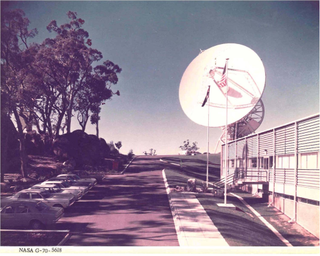How NASA Tracked Apollo 11 to the Moon and Back with 1960s Tech
One nation's arrival to the moon was in reality a global, far-reaching endeavor.

NASA relied on the U.S. State Department to implement an extensive global network of antennas to collect radio signals from the Apollo missions, including the first moon landing, which occurred 50 years ago.
The monitoring system, collectively referred to as the Spaceflight Tracking and Data Network, has gone through various incarnations: It cut its teeth tracking the first artificial satellites around Earth.
By the time the first American flew in space, NASA had already established at least 30 ground stations on five continents; several islands; and aboard ships sailing the Atlantic, Indian and Pacific oceans, according to author Sunny Tsiao in the NASA History Series digital book "Read You Loud and Clear!" (2008).
Related:
- Apollo 11 at 50: A Complete Guide to the Historic Moon Landing
- Relive the Apollo 11 Moon Landing Mission in Real Time
- Apollo 11 Moon Landing Giveaway with Simulation Curriculum & Celestron!
This electronic link to spacecraft and astronauts involved "two million circuit miles of land and ocean floor cables," reaching from remote volcanic atolls to cities like Madrid and Canberra, Australia, Tsiao wrote. When antennas collected data, computers and electronics on the ground converted all of it into information that users on Earth could analyze for checks on the health and status of the spacecraft.
Once crewed spaceflight became a reality, engineers at the Goddard Space Flight Center in Maryland and the Manned Spacecraft (now the Johnson Space) Center in Houston created the network that tracked the Apollo astronauts to the moon and back, abbreviated as MSFN (initially known as the Mercury Space Flight Network, the "M" changed to "'Manned" later on.) Goddard ran the entire network.
"And all that data — voice data, telemetry data — all came down and eventually went through Goddard before going to Houston," NASA lunar scientist Noah Petro told Space.com. "Goddard was and still is basically NASA's hub for communications."
Get the Space.com Newsletter
Breaking space news, the latest updates on rocket launches, skywatching events and more!

The State Department played a crucial role in helping NASA work with foreign governments to place antennas for the network, particularly where the U.S. was less popular and tensions ran high, Tsiao wrote.
In other cases, like Australia, countries were eager to take part and the U.S. encouraged them to take the helm of the communications stations. NASA selected the Parkes Observatory in New South Wales, Australia, to receive the remote Apollo 11 moonwalk readings, or telemetry. The 85-foot antenna at Honeysuckle Creek to the south, near the city of Canberra, received video of Neil Armstrong and Buzz Aldrin as they took the first steps on the moon. The latter instrument is still in use, but has since moved to nearby Tidbinbilla.

Officials at NASA wanted to maintain contact with Apollo's Eagle lunar module as it descended to the moon's surface after emerging from behind the moon. If the Apollo 11 crew needed to abort the landing, there was a very short period of time in which they could make the decision. And the moon would be visible in Australia when this crucial moment was scheduled to occur.
Honeysuckle Creek carried most of NASA's communications with Armstrong and Aldrin during their extravehicular activity. The most crucial of those communications were biomedical data from the astronauts' Portable Life Support System backpacks. Most of the data from the Columbia command module, which carried astronaut Michael Collins, traveled to the 26-meter antenna at Tidbinbilla.
These telescopes are now part of the Canberra Deep Space Communication Complex. The CDSCC supports NASA's Deep Space Network, which now receives information from spacecraft much farther away in the solar system, including the Voyager probes that have crossed into interstellar space.
- Houston, We Have a Restoration! Apollo 11 Mission Control Reopens
- Presidential Historian Douglas Brinkley Talks JFK, Moonshots and Apollo 11
- NASA's Historic Apollo 11 Moon Landing in Pictures
Follow Doris Elin Salazar on Twitter @salazar_elin. Follow us on Twitter @Spacedotcom and on Facebook.
Join our Space Forums to keep talking space on the latest missions, night sky and more! And if you have a news tip, correction or comment, let us know at: community@space.com.

Doris is a science journalist and Space.com contributor. She received a B.A. in Sociology and Communications at Fordham University in New York City. Her first work was published in collaboration with London Mining Network, where her love of science writing was born. Her passion for astronomy started as a kid when she helped her sister build a model solar system in the Bronx. She got her first shot at astronomy writing as a Space.com editorial intern and continues to write about all things cosmic for the website. Doris has also written about microscopic plant life for Scientific American’s website and about whale calls for their print magazine. She has also written about ancient humans for Inverse, with stories ranging from how to recreate Pompeii’s cuisine to how to map the Polynesian expansion through genomics. She currently shares her home with two rabbits. Follow her on twitter at @salazar_elin.
Most Popular

